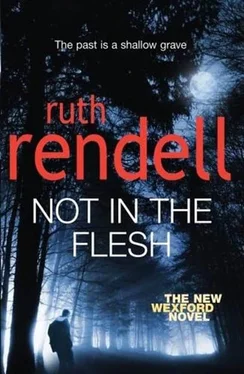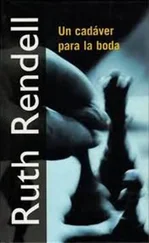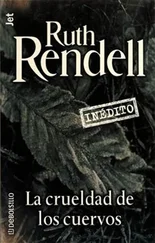“Would you have said that about foot-binding in China? Interference with ancient traditions put an end to that. One day perhaps interference will stop the artificial lengthening of women's necks in northern Burma.”
One of the few men in the audience asked what was men's attitude to the practice and was given what sounded to Wexford like anecdotal evidence. After that the question of a title for the new association was considered, and the name Kingsmarkham Association Against Mutilation or KAAM, pronounced “calm,” was decided on. It was time for refreshments, glasses of red and white wine (ignored by the Somalis who were mostly Moslems), orange juice, and fizzy water. For some reason, he had supposed, if he thought about it at all, that all these women would speak English reasonably well, so he was surprised when his neighbor Iman Dirir introduced him to a woman she called “the interpreter.”
“We have no terms in Somali or English for these parts of the body,” she told him with a sad smile. “The people need someone to explain the British laws to them. Most people who come here from Africa don't know there is such a law. They don't know circumcision is forbidden.”
She was tall and statuesque, far from young, but still beautiful in that goddesslike way more usually associated with Native Americans, the aquiline nose, the prominent cheekbones, the long neck and long hands. But as he again looked around him and surveyed all the women present, he saw that without exception all were either good-looking or extremely beautiful, their looks matched by their grace of movement and, in the older ones, by their dignity. He sighed to himself because it sometimes seemed to him that man had only to see beauty in order to wish to ruin it.
He gave Mrs. Dirir a lift home. She wore a long gown and the scarf but no all-enveloping jilbab as some of the women had. Alone with him she was shy, but when he mentioned his daughters she began to talk freely about how much she admired Sheila, whom she had seen in a television serial rerun. They were nearly at her house when she said, in a breathless way as if she had been working up to this for some minutes, “I have two daughters. They are grown up now. I want you to know that we came here, my husband and I, when they were little to save them from mutilation. I was afraid because I thought we would be sent back, but my husband is a scientist from Cairo University, so we were allowed to stay.”
“I'm glad,” he said. “I'm very glad.”
A European woman in a long dress would have gathered up her skirts but Iman Dirir let her gown hang untouched, held her head high, and glided up the path. When she reached the door, she turned once, raised her hand in a gesture that was more graceful than a wave, and let herself into the house.
Dental records are useful only if you have some idea as to whose body you are looking at. These were Carina Laxton's words to Wexford. She told him that she could come a little closer to the death date of the body in the cellar. Between eight and ten years, she now thought. In the case of the body in the trench, she was prepared to fix on eleven years. Wexford was far from taking Burden's and Hannah's view that this was the remains of Douglas Chadwick on the grounds of who else could it be. For one thing, there was no evidence that he had met a violent death at someone else's hands and, for another, no apparent motive for Grimble father or son to have murdered him. The clothes, he thought, were the only clue as to who this was, but so far, three days after a photograph of the T-shirt and the sneakers had appeared in national newspapers and the Kingsmarkham Courier, no one had come forward to acknowledge recognition.
Dilys Hughes had provided a DNA sample to be compared to that of the body in the trench, and this time the comparison would be sound. There was no doubt she and Peter Darracott were sister and brother, without the complications of stepfatherhood or adoption. As to dental records, the difficulty was that, according to Christine Darracott, her husband hadn't been to a dentist since he was at school and, as far as she knew, had had two fillings and one extraction when he was in his teens. The body in the trench had three fillings, and several extractions, but at different points in the dentition from where Christine said Peter's were.
E-mails from well-meaning citizens flooded Wexford's computer. Hannah read them all carefully but had stopped printing them out. It wasn't until now that he had quite realized how many people simply vanished. Of course he was aware of the figures; statistics only begin to have much meaning when they apply to individuals, when the people who have been just numbers acquire names and ages and descriptions. The senders of the e-mails seemed to ignore the cut-off point of spring 1995 and wrote of a relative disappearing twenty years before or five years before. Many contributed stories of missing wives or girlfriends. The hundred and more Hannah read in one day all listed missing people, and then came one from a woman in Maidstone claiming to recognize the scorpion T-shirt. Hannah phoned her, then went to Maidstone to see her.
Janet Mabledon was in her fifties, a bright well-dressed woman who worked as secretary and receptionist at a medical center. She had taken Wexford's e-mail address from a television appeal for witnesses. A phone number had been given as well, but she had decided, she told Hannah, that Kingsmarkham police would be overwhelmed with phone calls while they might seldom receive electronic messages. Hannah smiled but said nothing. She showed her the photograph of the T-shirt, the same picture as had appeared on several television news programs.
“My elder son's name is Samuel,” Janet Mabledon said. “Of course he's always called Sam. I had that T-shirt printed for him. There used to be a shop in Maidstone that printed T-shirts for you, any picture you wanted with a name, and they claimed the ones they did would be unique. Both my sons were very keen on-well, reptiles, I suppose you'd call them, when they were young, snakes and scorpions and alligators, all that sort of thing. Boys are. Sam and Ben were fifteen and thirteen at the time I had the T-shirts done.”
“Ben is your second son, Mrs. Mabledon?”
“That's right. He's a research chemist now,” she said with pride, “and Sam teaches at a university in the United States. It was twelve years ago I had the T-shirts done. Sam's had that scorpion with ‘Sam’ printed underneath and Ben's had a crocodile with ‘Ben’ under it. Ben loved his. I suppose I should have known Sam was too old for that sort of thing. He absolutely refused to wear it, never even tried it on.”
Hannah smiled. “What happened to it?”
“Nothing for a while. Then I had a clear-out. Actually I was amazed to find it, it had never been worn. Ben had a girlfriend with a brother called Sam-it had got to be a very popular name-and we gave it to her for her brother. She lived at Myringham. That's near Kingsmarkham, isn't it?”
“When would that have been, Mrs. Mabledon?”
“Oh, a long time ago. Ten years? I don't know where that ex-girlfriend is now, but I can tell you her name. Her brother was at Myringham University when Ben knew her.”
“Where Douglas Chadwick was doing his engineering course,” Wexford said to Burden that evening. They were back in the snug at the Olive and Dove, and their wives were with them. Some of their most valuable deductions were made over a drink in this quiet little room, but the Kingsmarkham Courier saw these meetings in a different light. The newspaper took every chance to run a spiteful story about police negligence and laziness. Now that it was possible for one of its reporters to blunder into the snug “by mistake” and take a photograph on his mobile, nowhere was private. But they had found, rather strangely, that if Dora and Jenny came with them, the press seemed to regard their visit as normal time-off socializing and took no action. Hannah, of course, believed some monstrous chauvinism was involved here but found it difficult to say quite how.
Читать дальше











